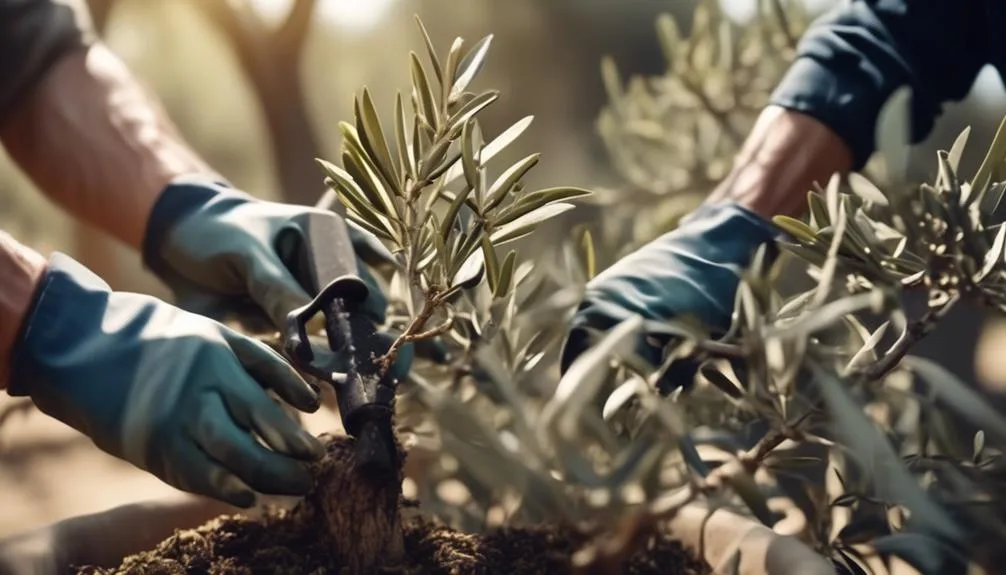Caring for olive trees can be quite a task. It involves lots of pruning, pest control, and disease prevention. But is it really as tough as it sounds?
Let's take a closer look at the work involved in looking after olive trees and see just how demanding it can be.
Key Takeaways
- Pruning and trimming are important for promoting healthy growth and fruit production in olive trees.
- Effective pest and disease control is crucial for maintaining tree health and productivity.
- Careful management of watering and fertilizing is essential for optimal growth and health.
- Harvesting and processing olives for oil production can be labor-intensive but rewarding.
Pruning and Trimming
When caring for an olive tree, pruning and trimming are essential tasks to promote healthy growth and fruit production.
Understanding the growth patterns of olive trees is crucial for effective pruning. Olive trees typically have a central leader, and pruning should encourage an open canopy to allow sunlight penetration and air circulation.
It's important to use proper equipment such as sharp bypass pruners and loppers to make clean cuts without causing damage to the tree.
Regularly trimming dead or diseased branches not only improves the tree's appearance but also reduces the risk of pest and disease infestations.
Pest and Disease Control
In order to maintain the health and productivity of your olive tree, it's crucial to implement effective pest and disease control measures. This can be achieved by building on the foundation of proper pruning and trimming. Integrated pest management combines natural remedies and proactive strategies to minimize the use of chemicals. Choosing disease-resistant olive tree varieties can also reduce the need for extensive pest and disease control.
Organic control methods, such as using beneficial insects and applying neem oil, can help manage common olive tree pests like fruit flies and scale insects. Regularly inspecting your olive tree for signs of disease or pest infestation is essential for early intervention. By incorporating these practices, you can effectively manage pests and diseases while promoting the overall health of your olive tree.
Watering and Fertilizing
To ensure optimal growth and health of your olive tree, it is essential to carefully manage its watering and fertilizing regimen. Proper watering is crucial for maintaining ideal soil moisture levels, while fertilizing is necessary to ensure the tree receives adequate nutrient levels.
Here's a table summarizing the watering and fertilizing requirements for your olive tree:
| Watering | Fertilizing |
|---|---|
| Deep, infrequent watering to encourage deep root growth | Fertilize with a balanced, slow-release fertilizer in spring |
| Monitor soil moisture to avoid overwatering or underwatering | Consider additional nitrogen fertilizer if leaves appear pale |
| Adjust watering frequency based on weather conditions | Avoid excessive fertilization, which can lead to salt buildup in the soil |
| Use mulch to help retain soil moisture | Test soil nutrient levels before applying fertilizer |
Harvesting and Processing
Once your olive tree has reached maturity and the fruits have ripened, it's time to begin the process of harvesting and processing the olives. Harvesting and processing olives for olive oil production can be a labor-intensive but rewarding process. Here are some key points to consider:
- Hand-picking: Hand-picking olives is a traditional method that ensures careful selection and minimal damage to the fruit.
- Sustainability practices: Consider implementing sustainable practices, such as using organic fertilizers and minimizing water usage, to promote environmental stewardship.
- Olive oil production: After harvesting, the olives need to be processed to extract the oil. This involves crushing the olives into a paste and then pressing the paste to extract the oil.
Overall Maintenance
Engage in regular pruning and irrigation to ensure the health and productivity of your olive tree. Pruning helps promote better fruiting and overall tree vigor, while proper irrigation ensures that the tree receives adequate moisture.
When it comes to soil composition, olive trees thrive in well-draining, nutrient-rich soil. Consider conducting a soil test to determine the pH level and nutrient content, and then amend the soil as needed.
Climate considerations are crucial for olive tree maintenance. These trees prefer a Mediterranean climate, characterized by hot, dry summers and mild, wet winters. If you live in a region with a different climate, you may need to provide additional care to ensure the tree's well-being.
Conclusion
In conclusion, caring for an olive tree may seem labor-intensive, but with proper maintenance, it can be a rewarding experience.
The process of harvesting and processing olives adds to the satisfaction of tending to these trees.
With a little effort and attention, you can enjoy the beauty and benefits of growing your own olive tree.

